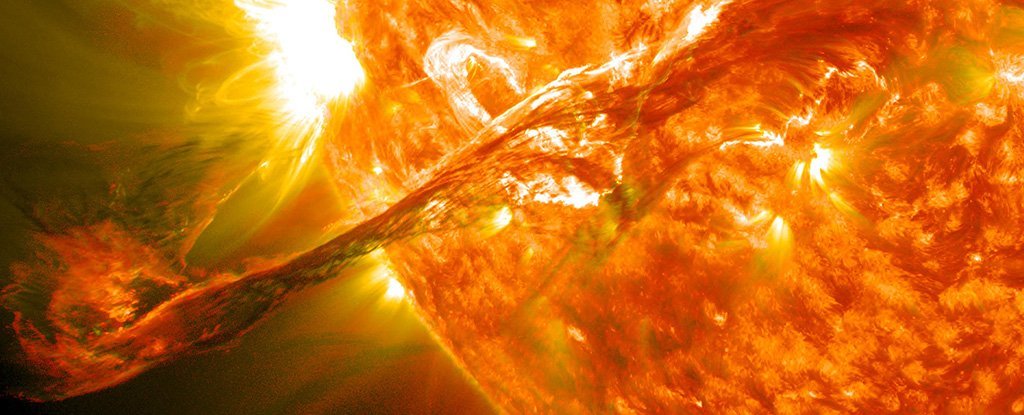The formation and evolution of our Solar System is one of the cornerstone problems of modern astronomy.
One widely accepted yet incomplete model suggests that a portion of
large and dense molecular cloud collapsed at a point, to form a
protostar and a protoplanetary disk surrounding it. As this proto-Sun
evolved to a more stable form, the gas and dust surrounding it cooled
and coagulated to form small and large bodies that we see today as
asteroids, comets, rocky planets and gas giants.
Scientists say that the Solar System matured to its present form
about a million years from its birthdate. Today, it is around 4.5
billion years old, nearly midway in its lifecycle.
The first solids formed within the infant system’s hot bakery, and
the calcium-aluminium-rich inclusions (CAIs) among them can help us
figure out what exactly happened in those early years. CAIs can be found
only inside the bodies of chondritic meteorites, and consist primarily
of refractory oxides and silicates of calcium, aluminium, magnesium and
titanium.
Because these meteorites first formed at the time the Solar System
was going through its birth pangs, they contain the same abundance of
elements and their isotopes as was prevalent at the time. So they are a
sort of spacefaring museums preserving physical and chemical information
from a long-gone era.
This detail is important because of beryllium.
Also read: Search for Source of Plutonium Isotope Sets Cap on Gravitational Wave Detection
Hydrogen, helium, and some lithium-7 – the lightest elements – formed shortly after the Big Bang. All
the other elements and their isotopes could technically form within
the wombs of stars
– and they all did with the exceptions of lithium, beryllium and boron.
The nuclei of these elements have very low binding energies to be able
to form inside a star.
Nuclear physicists have found that the beryllium-9 and beryllium-10
isotopes in space must have been formed by spallation reactions – in
which energetic hydrogen and helium atoms bombard heavier atomic nuclei
and break them down into lighter atoms, including those of beryllium.
“Bombardment of carbon and oxygen atoms in the protoplanetary disk by
[energetic solar particles] emitted in superflares lead to the
formation of various beryllium isotopes,” Ritesh Kumar Mishra, a
cosmochemist at the Heidelberg University, Germany, told
The Wire.
Earlier, scientists believed that beryllium had been produced within
the gas and dust floating in interstellar space before the Solar System
existed. However, the abundance of beryllium-10 in the Allende meteorite
– which crashed over Mexico in 1969 – suggested it had likely been
produced much before the actual birth of the Solar System itself.
Recent advances in stellar nucleosynthesis have prompted scientists
to consider two new production pathways for beryllium-10: the supernova
explosions of low-mass stars and
radiation from a young Sun.
Before coming to Earth, meteorites typically spend millions of years
roaming outer space, where they are exposed to cosmic rays and other
high-energy particles, thus contaminating their CAI content. So before
analysing the meteorites, scientists make some corrections in their
analysis to account for the actual abundance of the elements during the
Solar System’s formation.
The planetary science community has suspected that the beryllium-7
isotope must have formed with beryllium-9 and beryllium-10 when the
Solar System was itself being formed. However, they didn’t have evidence
to validate their doubts. Beryllium-7 is a short-lived, and now
extinct, nuclide, with a half-life of just 53 days, so by now it should
have decayed into lithium-7, a more stable isotope.
However, older studies couldn’t properly account for the relative
abundance of various isotopes and couldn’t trace any signatures of
beryllium-7 in the form of an excess amount of lithium-7.
Recently, Mishra and
Kuljeet Kumar Marhas, a planetary scientist at the Physical Research Laboratory (PRL), Ahmedabad,
analysed samples
from the 21-kg Efremovka meteorite that fell over present-day
Kazakhstan in 1962. The Efremovka meteorite is one of the most pristine
meteorites on Earth – i.e. one of the best museums of the elements of
the early Solar System.
Also read: A Planetary Scientist and Her Box of Pre-Solar Grains
To their surprise, the duo found that the ratio of the abundance of
lithium-7 to lithium-6 correlated with that of beryllium-9 to lithium-6,
suggesting that the beryllium-7 had decayed to lithium-7 within the
CAI. Also, the portions with a higher content of beryllium-9 within the
sample showed a higher mean value of the lithium-7-to-lithium-6 ratio as
well. This implied that the beryllium-7 and -10 isotopes could have
been formed under the influence of radiation from an embryonic Sun.
As the authors write in their paper,
A late (~0.5 [million years ago])
superflare with X-ray luminosity … that irradiates precursor solids of
CAI … can simultaneously explain the isotopic, petrographic and
diffusivity constraints, and the model calculations. Such a superflare
can provide the required flux of ~1010 protons cm-2 s-1 … to produce the observed isotopic abundance in the CAI.
“The nascent Sun was very dynamic and hyperactive,” Mishra said. “It
used to emit superflares a million-times stronger than the
strongest-ever-observed flare.”
Mishra and Marhas also found evidence to suggest that the CAIs, after
formation, would have been pushed to distances 1-1.5-times the
Sun-Earth distance, where they would have cooled and become trapped in
other minerals that formed the present-day asteroids.
Unlike contemporary astrophysics, where one is obliged to observe and
conclude, the current study highlights the experimental side of the
astronomical sciences. Mishra and Marhas performed their analyses and
experiments with a cutting-edge instrument called the secondary ion mass
spectrometer (NanoSIMS), only one of which is available in India – at
PRL, where Marhas works.
A highly sophisticated instrument, “NanoSIMS first generates the
specimen from the meteorite sample by bombarding it with heavy ions,”
Mishra said. “Then, it is employed to study and analyse the specimen
without destroying the whole sample.”
This study provides a clearer picture of how the Sun behaved in its
younger years. It also brings us a big step closer to understanding how
the Solar System formed.
Mywish Anand is a
winter intern at the Kodaikanal Solar Observatory. He has a masters
degree in computational physics from the Central University of Punjab,
Bathinda.











